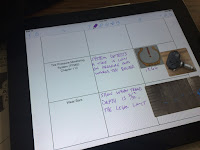Student Control
Last year I wrote a blog post about +Katelyn Schipits and a lesson that changed dramatically from the way she had envisioned it. The premise of the post was that in order for the lesson to go well, she had to give up control. Since writing that post, I’ve thought a lot about what control I have in my class and what role student control has. I agree with Katelyn, and her mentor +Linda Pribyl, that sometimes giving up control leads us to even better places than we had originally imagined.
With this reflection, I’ve been pushing myself to see where I can give up some control in my classes. This week I experimented with this control shift in a big way (at least in my world). Normally in my classes when we tackle a grammar topic, I provide the students with a flipped video lesson, a few formative assessments, some practice activities, etc. In my Honors Spanish 3 class this week, we were set to review the preterite vs. the imperfect (insert ominous music here). This is a topic that they worked on in Spanish 2 last year and we cover again this year (and they’ll work on again in Honors Spanish 4).
Keeping that and a conversation I had with +Dawn Bodden in mind, I tried something different. In an effort to concede some control, rather than providing the students with all the materials, I assigned them a homework assignment to collect information on the topic. I asked them to research the ins and outs of the preterite vs. the imperfect including uses, time tags, common pitfalls, etc. and write down the information somewhere in Notability or a real notebook.
In the following class, instead of leading the discussion, I first asked the students to talk in small groups and compare what they had found. I did write a few questions on the board to give the students a little direction. After about 15 minutes, I asked the students to share with the whole class on the board what they had discussed. During both parts of the class, the students did a really great job of addressing most of the issues about the subject. The students were engaged and I was really happy with how class unfolded.
During the following class, the students did the same activities, but with a different topic (pronouns). After having seen it in action on Tuesday, I did make a slight adjustment. Before class I wrote a very rough skeleton on the board. While I like what I had done with the leading questions during the first class, I wanted the actual physical information to be a little bit more ordered visually. Again, the students had great conversations and contributed really well. In the end, I feel that they had covered all of the information that I would have given them.
But I’m a teacher...and I’m definitely Type A. Giving up control does not feel very natural to me. It scares me a little. At the same time, when I wasn’t in control, the students were. And they (for the most part) rose to the challenge. I loved seeing them take ownership of the material and talk about it in authentic conversations that were driven by them.
The only step left is the results. Since I just tried it Tuesday and Thursday, I won’t have any tangible data until next week when I assess them. I’m cautiously optimistic, as they say. And I’m eager to find more places in the curriculum that I can have the students take control.
Obviously I’m not the first teacher to think of putting the onus on the students. I know that a lot of teachers here use Socratic Seminars for just this reason. I also know that we have an unbelievably creative staff. Please share your great ideas in the comments section so we can all continue to learn from each other.


Another teacher sent this along to me at the beginning of the school year and it changed my way of thinking about releasing responsibility in the classroom :)
ReplyDeletehttps://www.teachingchannel.org/videos/modeling-strategy-getty
Thanks for sharing, Katie!
ReplyDelete